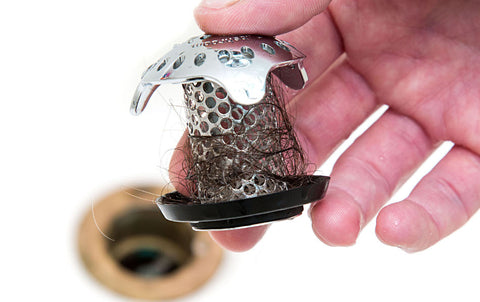
Do-It-Yourself Solutions for a Slow Flushing Toilet
Share
On the surface, a slow flushing toilet shows similar signs to slow drains in the bathroom sink, kitchen sink, showers, and bathtubs. Slow moving water around drains is an indication of clogging, but it's not that simple with a toilet.
A toilet contains several moving parts that need to work cohesively. One mishap and the toilet no longer functions. To help you identify what's gone wrong with your toilet, we'll cover the reasons a toilet flushes slowly, how to tackle them, and ways to prevent this problem from coming back.
Common Causes of a Slow Flushing Toilet

There are two reasons the toilet flushes slower than normal, and they relate to the toilet drain and the water supply. When one or both is not functioning properly, you get a slower toilet flush. Consider the list below subcategories of issues, all of which are a result of the drain or water supply not operating correctly.
Drain Blockage
A fully clogged toilet won't move waste down the drain at all. If it's running slowly, it's a partial clog that does let water through, but not as fast as it's supposed to be. Toilet drain clogs occur when human waste, toilet paper, or objects such as wipes, dental floss, hair, napkins, medicine, toothbrushes, toys, and feminine products get stuck in the drain and can't move.
Low Water Level
The water tank needs enough water inside of it to flush out waste and fill the toilet bowl while maintaining its water level. A low water level in the tank means it doesn't have enough water to flush and fill, which will make it so you need to flush 2-3 times to clear the bowl.
Most toilets have a line inside the tank structure, and that line relates to water level. If your toilet doesn't have a line indicator, you should keep the water between 1/2 and 1 inch below the overflow tube and fill valve.
Mineral Buildup
Underneath the toilet bowl rim are jet holes. Also called rim holes, the jet holes aid in flushing waste down the drain. These holes are the source of fresh water filling the tank after flushing.
Jet holes rely on water pressure to transfer water from the tank into the toilet bowl. Over time, minerals can build up along the rim due to the calcium and magnesium in hard water. A clogged rim reduces the pressure and velocity of water as it enters the tank.
Faulty Flapper Valve
The flapper valve opens up the passage that lets water through from the toilet tank to the toilet bowl. It triggers the flushing pressure simultaneously. The flapper valve creates a tight seal around the passage when closed. Over time, the tight seal loosens and wears out, meaning it cannot seal the passage tightly. This creates a continuous running sound, contributing to slow flushing.
How to Remedy a Slow Flushing Toilet
The easiest solution is pouring liquid drain cleaners down the toilet bowl drain, but easy doesn't equal best. Liquid cleaners have harsh chemicals that contaminate the water system, increase clogs, and erode the toilet coating finish.
These cleaners can also weaken pipe structure, causing leaks in the basement or crawlspace and damaging floor structure. Continuous leaks can cause the toilet and the floor around the toilet to cave in, creating a gaping hole.
Stop using liquid drain cleaners and start using these techniques to remedy the situation instead.
Dishwashing Liquid and Hot Water
The same dish soap used to clean dishes can also loosen toilet drain buildup around the pipe interior so the toilet can flush faster. Hot water will remove the loose buildup from the pipe interior into the water.
- Start to boil a gallon of water in a pot on the stove. Take the water off the stove before it fully boils.
- Grab dishwashing liquid and pour two cups of it down the drain.
- Let it sit for 30 minutes.
- Pour the hot water inside the drain.
- Let it sit for 30 minutes.
- Flush the toilet.
Clean Clogged Jet Holes
The best solution to clean mineral deposits around the rim is to have a toilet brush with an under-rim lip brush handy. Use the under-rim lip brush to clean jet holes around the rim.
If you have a toilet brush without an under-rim lip brush, you can use a wire coat hanger, a straightened-out paper clip, a small hex key, or a toothbrush as a substitute. Clean the jet holes with vinegar or dishwashing soap.
An alternative to cleaning the jet holes is pouring vinegar down the overflow tube. Let the vinegar sit there overnight. Flush the toilet the next day.
Plunger
One of the most effective remedies for toilet drain issues is a plunger. So, put on rubber gloves, grab your plunger, and place the seal on the toilet drain hole. The first plunge should be slow — a fast plunge motion means water splashes all over you and the floor. Continue to plunge slowly until the air inside the plunger leaves and the suction creates a firm seal. Speed up the plunging movement and continue to do that 30 times. Flush the toilet. Repeat the process two more times.
Plumber's Snake
Also called a drain snake, toilet snake, or auger, the plumber’s snake is effective in reaching clogs far down the pipe and pulling them out for wastebasket disposal.
Because the drain has many curves as it leaves the toilet, only experienced homeowners should use the snake. The snake can get stuck in the pipe and scratch the toilet bowl, making a slow flushing toilet worse.
Plumber
Complicated problems related to the toilet tank such as fill valve, float arm, and flapper valve issues are not a DIY job. A plumbing contractor knows how to tinker inside the toilet tank.
If the above steps are not working, this expert will use the latest equipment to remove clogs from toilet drains. If necessary, the professional will turn off the water valve, remove the clogged pipe, clean it, and reinstall it. The plumber can also add a brand new plumbing pipe if the situation calls for one.
How to Prevent a Slow Flushing Toilet

After toilet repair, use these preventative measures to stop toilets from flushing slowly so it doesn’t become a daily or weekly occurrence. For best results, perform all these tips frequently to keep toilet drains clear and flushing fast.
Clean the Toilet
Avoid chemical cleaners, and opt for one of these safe household products to clean the toilet instead: Lemon juice, dishwashing liquid, baking soda, or vinegar. The pleasant smell of these items is better to sniff than harsh chemicals. As you clean the toilet, clean the toilet bowl and the drain hole with a toilet brush. Use an under-rim lip brush to clean jet holes.
ToiletShroom
A plunger and squeegee in one, the ToiletShroom complements the toilet brush by pushing clogs out and cleaning the drain simultaneously. Its flexible base fits all the way inside the curved toilet drain while the handle is long enough for you to avoid touching the toilet entirely. It includes a caddy to store it when it's not in use.
Dish Liquid and Hot Water
This home remedy used to unclog a slow flushing toilet is also excellent at preventing clog buildup. Pour dish liquid and hot water down the drain, let it sit, and flush afterward. Do this continuously for effective results.
Rethink Your Toilet Paper
Many sites tell people it is fine to flush toilet tissue down the toilet. In reality, toilet paper is a major clog contributor in toilets and a primary reason toilets back up or become slow to flush. Biodegradable toilet paper is durable and dissolves in toilet water with ease.
Keep the Toilet Seat Down
Some people like their toilet seat up, but foreign objects can easily land in the toilet water, forcing you to scoop it out and clean it or toss it in the wastebasket. If the object accidentally gets flushed down the drain, it can cause a clog. With the toilet seat down, you can protect the toilet from foreign objects and accidental drops.
ToiletShroom: The Magic Wand That Makes Clogs Disappear
A toilet is not meant to be a second trash can for non-degradable waste. It's meant to flush human waste down the drain and lead it out of the home.
Your toilet cannot do its job if there are problems with the toilet drain, jet holes, or toilet tank. A slow flushing toilet is an annoying interruption to your daily routine, so try the DIY solutions above to resolve your toilet trouble and ease your mind, body, and soul.
Are you looking to eliminate plumbing problems and clogged drains for good? Look no further than our complete 'Shroom drain protection line! We have award-winning solutions for every drain in your home.
Check out these two videos on more tips for fixing your slow flushing toilet.
Say Goodbye to Clogged Drains Forever
We here at the TubShroom Company have made it our mission to protect every drain in the world from clogs. We know how annoying it can be to see that dirty water start backing up. Hair is the #1 cause of clogged drains, so we set out to develop products that can catch every hair, every time. Learn more about our TubShroom family of products here.
When your bathtub, shower, sink, or toilet drain clogs, you either try a "snake" device to clear it out or--more typically--you pour harmful chemicals down the drain to try to dissolve the clog. When those attempts fail, the next step most people take is to call on a plumber who may charge upwards of $200 to clear the clog. TubShroom products can prevent clogs before they occur.
View all our top-selling, award-winning TubShroom products here. From the TubShroom to SinkShroom, and DrainShroom to ToiletShroom, there's something for everyone. Click here to product your drains for good.
Disclosure: Links in this article are affiliate links to Amazon products. As an Amazon Associate, we earn from qualifying purchases.
More Articles from The Shroom Company
How to Unclog a Toilet Without a Plunger
5 Common Plumbing Problems and How To Avoid Them
How to Unclog a Kitchen Sink: 5 Methods for Home Use
How to Clear Blocked Drains and Prevent Future Clogs
What to Do When Your Toilet Won’t Unclog








